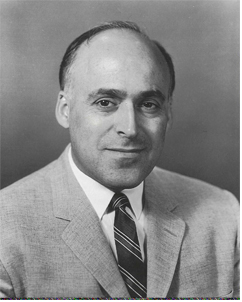Dr. Joseph Serrazza
 After graduating from Cooper Union
School of Engineering in 1941, Joseph Sperrazza embarked on a 38-year Department of the Army career as an
engineer, researcher, and systems analyst for the Ordnance Corps' Ballistics Research Laboratory,
culminating as Director of the US Army Materiel Systems Analysis Activity (AMSAA) at Aberdeen Proving Ground
(APG). In the process, he earned an M.S. and Ph.D. in engineering from Johns Hopkins University.
After graduating from Cooper Union
School of Engineering in 1941, Joseph Sperrazza embarked on a 38-year Department of the Army career as an
engineer, researcher, and systems analyst for the Ordnance Corps' Ballistics Research Laboratory,
culminating as Director of the US Army Materiel Systems Analysis Activity (AMSAA) at Aberdeen Proving Ground
(APG). In the process, he earned an M.S. and Ph.D. in engineering from Johns Hopkins University.
Dr. Sperrazza carried out pioneering work in the fields of systems analysis, wound ballistics, and weapons effects to ensure that the best possible weapons and equipment were developed and fielded.
He chaired the Joint Technical Coordinating Group for Munitions Effectiveness which assessed weapons effectiveness in Vietnam and resulted in a three-volume study on wound data.
The Battlefield Damage Assessment and Reporting Team extended this work into the area of weapons effects on materiel. Wound data and studies of weapons effects led to the development of Kevlar body armor, armor plate, and helmets as well as improved small arms ammunition for automatic weapons. Likewise, his studies of gun tube erosion and its effect on ballistics led to improvements in artillery systems.
Dr. Sperrazza's research into weapons and munitions effects also led to many improvements in equipment survivability. Under his guidance, AMSAA developed the TOW antitank system under armor, increased helicopter survivability through improved design of critical parts, added lightweight armor to the S-280 Shelter, and configured safer storage for propellant charges on the M109 self-propelled howitzer.
Starting in 1968, Dr. Sperrazza led AMSAA in performing systems analysis studies in support of research and development efforts by the arsenals, commodity commands, project managers, and the Department of the Army staff. These studies identified where efficiencies could be realized without sacrificing effectiveness and resulted in millions of dollars saved in the procurement of LORAN (Long-Range Navigation), SLAE (Standard Lightweight Avionics Equipment), and wheeled and track vehicles.
He also applied systems analysis to the research and development process itself, improving the design of experiments, simulations, and tests by placing emphasis on the replication of realistic battlefield conditions.
A meticulous and exacting engineer, Dr. Sperrazza produced an enviable record of creative achievements, which have materially contributed to the strength of our military posture.
Dr. Sperrazza retired from AMSAA in 1979. He died in June 1998.